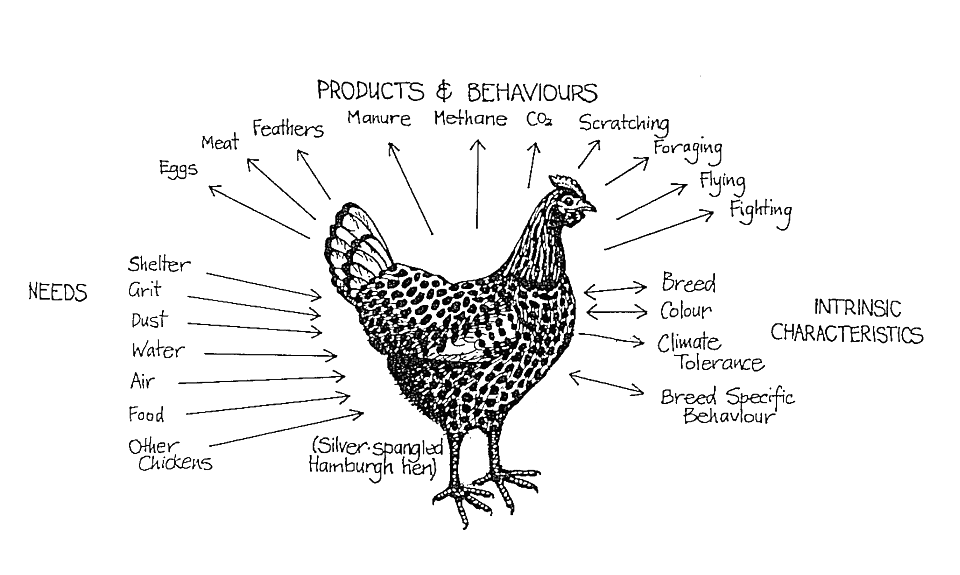Permaculture is Design
The Design Elements of a Chicken. Illustration from “Introduction to Permaculture” by Bill Mollison.
I first learned about Permaculture when Andrew was living out west at Bohdi Creek Farm. And from the moment he started describing the things he was learning while living there, I knew it was something life-changing. Who knew that, what would turn out to be an unplanned three month stint for Andrew in the Pacific NW, would end up being so influential on our lives?
If you are unfamiliar with Permaculture, here is the general synopsis from Wikipedia:
Permaculture is a branch of ecological design, ecological engineering, and environmental design that develops sustainable architecture and self-maintained agricultural systems modeled from natural ecosystems.
Andrew and I have talked about the general principles of Permaculture before and know some aspects of it from his time out west and the modest amount of research we’ve done, but something I read recently was sort of an “ah-ha” moment for me. It made things clear as to why the whole idea of Permaculture really speaks to me, and it’s basically this: Permaculture is design.
From “Introduction to Permaculture” by Bill Mollison:
“The core of permaculture is design. Design is a connection between things. It’s not water, or a chicken, or the tree. It is how the water, the chicken and the tree are connected. It’s the very opposite of what we are taught in school. Education takes everything and pulls it apart and makes no connections at all. Permaculture makes the connection, because as soon as you’ve got the connection you can feed the chicken from the tree. To enable a design component (pond, house, woodlot, garden, windbreak, etc.) to function efficiently, we must put it in the right place.”
I’m a visual communication designer by trade. It’s what I chose to go to school for and what I choose to do for a living. So reading that one of my major life’s goals is in many ways related to a skill that I’ve been developing for the past 10+ years made me incredibly happy. Obviously, this is just very high level comparison here. Any trade based in design will follow similar principles of taking many different elements and inputs and arranging and connecting them in various ways for different outcomes. Here is an image I found of a Permaculture design, where you can see how everything is considered in regards to the principles of Permaculture:
Though most of the elements, sources, and products of Permaculture design are different than the ones I’m accustomed to using in visual communication design, it’s the problem solving, strategy and the ability to find the inherent relationships between all the inputs that are the important qualities that bridge the two disciplines. Since these are skills that I’ve already been developing, I need to focus on adding all the elements and sources of Permaculture to my toolbox.
Permaculture has been around for a little while, so I’m sure I’m not the only graphic designer who has had this “ah-ha” moment. But this is my personal story about finding my way, so excuse me if sometimes I sound like an old person exploring the world wide web for the first time!
xo,
c.
P.S. I did find this great article: “Permaculture Principles Can Flourish in Package Design” by Daniel Halsey that relates each major principle of Permaculture to the process of package design. Which, again, could translate to most design fields.
Tags: Design, Garden, Living/Working Space, Permaculture, Sustainability

Pingback: Scratch Mommy – Life, From Scratch Creating a Permaculture Home - Scratch Mommy - Life, From Scratch